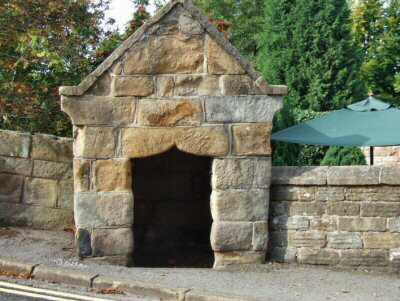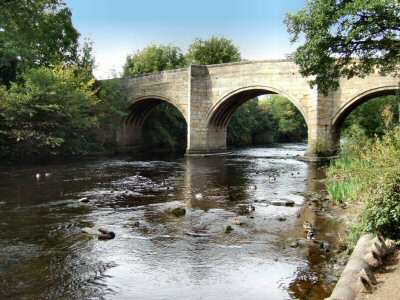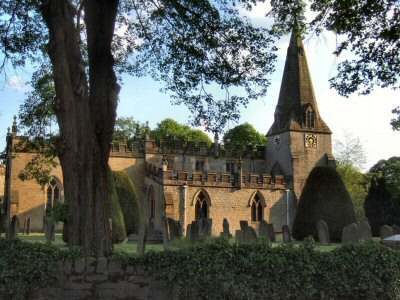BASLOW
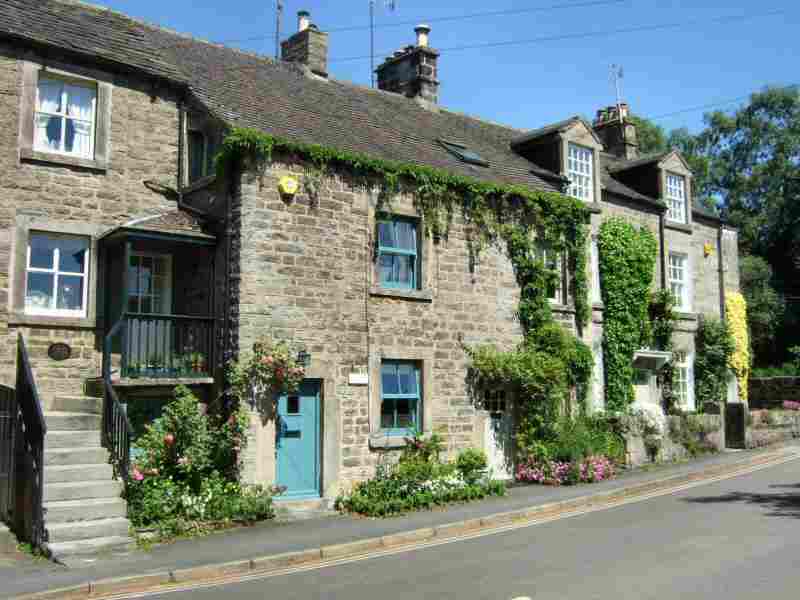
PLAN YOUR DAY OUT
Location: Baslow is on the A619 Chesterfield to Buxton Road, where the A621 from Sheffield and A623 from Whaley Bridge converge. (SK255723).
Visit: St Anne’s Church, note the different clock faces, and locate the dog whip in the church; stroll into Chatsworth Park through the Cannon Kissing Gate and walk to Chatsworth House; take a more strenuous walk up Bar Road to visit the Wellington Monument and Baslow Edge.
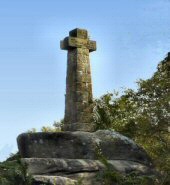
Refreshments: The village is well served with cafés, pubs and restaurants.
Walk: On leaving Goose Green, the walk leads you towards Chatsworth Park, passing a row of attractive thatched cottages before going through the fields to the rear of The Cavendish Arms. One of the Peak District’s best-known hotels, which is also famous for the ten miles of trout fishing it offers visitors. Continue through the old part of the village and cross the former packhorse bridge. After walking down Bubnell Lane, the path takes you across the fields to join a pleasant riverside walk to Calver. A long, steep climb up the road through Curbar Village, followed by several fields, brings you to Curbar Gap. Splendid views of the miles of countryside are obtained as you walk along Baslow Edge before dropping down a steep rocky path back to Baslow and the walk’s starting point.
Special Places of Interest in the Locality: Enjoy Chatsworth House, Garden, Farmyard and Adventure Playground for a great family day out. Visitors can wander the magnificent parkland free of charge. The house stands in a deer park laid out by ‘Capability’ Brown in the 18th century, with hills and woods. Shop and restaurant facilities are available. – Eyam Museum tells the dramatic story of the bubonic plague outbreak that decimated the village’s inhabitants in 1665/6. Local geology, archaeology and social and industrial development are all covered in this excellent little museum. – Explore Rowsley and visit Caudwell’s Mill, where various artisans still trade; the café and craft centre are closed at the time of writing. The Peak Village Shopping Complex at Rowsley is a great place to relax, look around the shops and visit the complex’s beautiful Nature Reserve.
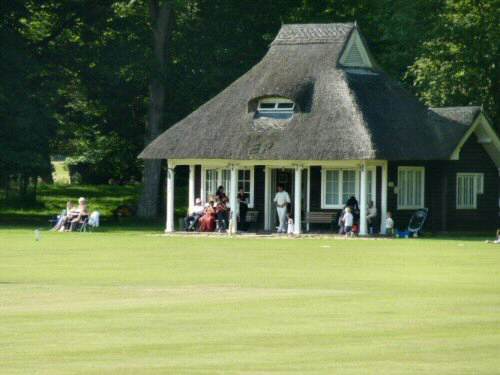
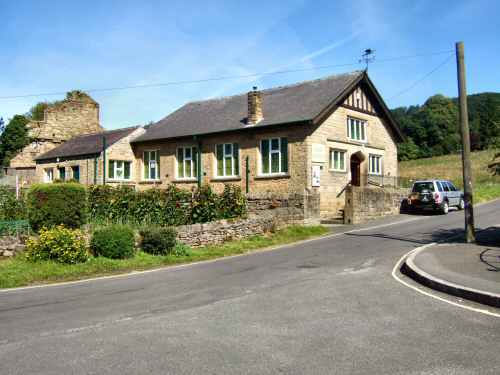
INTRODUCTION
Baslow is a busy little village in the Derwent Valley, with Chatsworth Park to the south. Baslow Edge rises to the north, where a stiff climb is rewarded with fantastic views. Nowadays, the Devonshire Bridge, built shortly after the First World War, carries most of the traffic across the river. But the Old Bridge, close to the church built in 1603, attracts the most interest from visitors with its impressive stone arches. It is the only ancient bridge across the Derwent that floods have never destroyed. It played a significant role in the history of Baslow, providing access to an important route over the moors to Chesterfield and the North Sea ports.
The present bridge replaced a wooden one that all able-bodied men in the village were required to watch on a rotating basis to ensure the weight restrictions were not broken. Anyone caught breaking the rules was fined. The tiny watchman’s hut remains, no doubt reduced in size by the heightening of the road. It once offered a shelter to Mary Brady, a local beggar, who often slept rough inside.
ST ANNE’S CHURCH
St Anne’s is both a beautiful and unusual church. One clock tower has Roman numerals and is dated 1759. The other has ‘Victoria 1897’ on its face to mark Queen Victoria’s Golden Jubilee. Inside the church, by the door, in a glass case, is a dog whip, which in the 17th and 18th centuries was used by the official ‘dog whipper’ to keep stray dogs in order during the service. The whip has a thong that is three feet long, which is still in excellent condition and bound around the handle with leather. Some historians also claim that it was used to maintain order among worshippers and to wake up those who snored during the service!

BASLOW HYDRO
Following improvements to the road network, it became easier for wealthy people from Sheffield and other cities to visit the country for health or recreational reasons. For 50 years, Baslow Hydro was the dominant feature in the village. Although falling short of spa status, the Hydropathic Hotel was set on spacious grounds with a croquet lawn, tennis court, and bowling green, all surrounded by gardens like a miniature park. There were nearly 100 bedrooms; in the 1890s, an annexe provided a further 20 or so bedrooms. It was a profitable enterprise until the First World War. However, trade dwindled, and it gradually fell into disrepair before closing in 1936 and being demolished. All that remains are two stone gateposts.
SEBASTIAN DE FERRANTI
Sebastian de Ferranti lived at Baslow Hall in the early 20th century. He was a ‘do it yourself man’, passionate about electricity. He experimented with central heating and other electrical appliances and fitted double-glazing. Sadly, his efforts at battery poultry farming had disastrous consequences for the chickens, who were electrocuted.
COLONEL E M WRENCH
Another well-known character was Lieutenant Colonel E M Wrench, who, in 1862, took over a medical practice in the village. He was a surgeon who had served in the army in Crimea and India and was a great patriot. In 1866, he built Wellington’s Monument on Baslow Edge, the ten-foot-high cross visible over a wide area. In Chatsworth Park, he carved an inscription on the face of what is now known as Jubilee Rock to commemorate Queen Victoria’s Golden Jubilee. The rock was previously known as the Elephant Stone. Queen Victoria would not have been amused! For her Diamond Jubilee, Lieutenant Colonel Wrench refaced Baslow’s church clock.
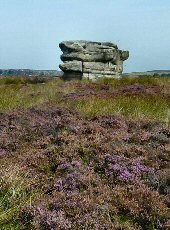
THE EAGLE STONE
Standing in solitary confinement on Baslow Edge is a massive boulder known as the Eagle Stone. According to legend, it took its name from the god Aigle, who appeared to have a habit of throwing boulders around. In the past, no local lad was considered fit to marry until he had shown his fitness and agility by climbing to the top of the stone.
NETHER END
The most popular part of the village is Nether End, which has hotels and little shops set around Goose Green, where people can sit comfortably and relax. From here, the parklands of Chatsworth are approached over a 17th-century Packhorse Bridge and past a row of thatched cottages to enter the Park through the Canon Kissing Gate.
GOLDEN GATES
Situated just off the A623 is the private northernmost entrance to the Chatsworth estate. Once, it had golden gates, but following an accident when an out-of-control lorry demolished them, the gateway had to be rebuilt.
THE VILLAGE
The village is well-served by restaurants, cafés and shops. Opposite the church is a group of shops housed in a handsome block of buildings. Along the Bubnell road, several of the cottages were used for weaving and, at one time, for making felt hats. Further to the west is the 17th-century Bubnell Hall, of which Baslow Hall is a copy on the opposite side of the river.
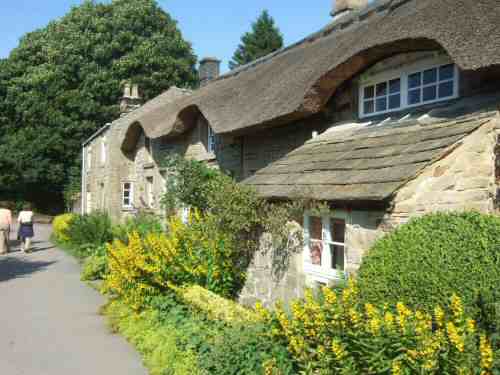
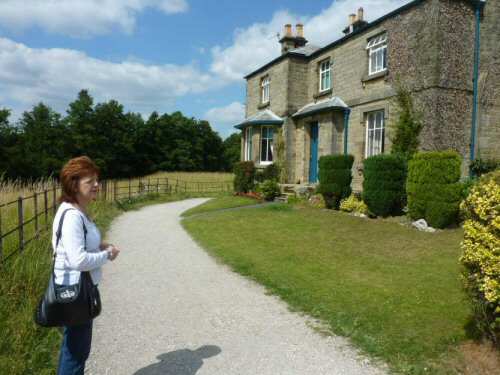
TEN FASCINATING FACTS ABOUT BASLOW
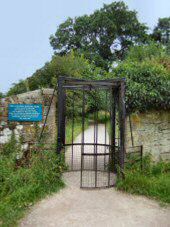
1. To get a better look at the fine quality of craftsmanship beneath the arches of the Old Bridge, walk down to the water’s edge by the side of the church. This is also an excellent place to watch wildlife and spot trout in the river.
2. The village is divided into three main sections—Bridge End, the original, clustered around the church and the ancient bridge across the Derwent. To the east is Nether End, the modern centre where tourists tend to head with its hotels, restaurants, cafés and pedestrian entrance to Chatsworth Park. Over End is the residential area on the hillside north of the village centre.
3. Chatsworth Park is entered/departed through the skillfully designed Cannon Kissing Gate. The gate allows wheelchair access to the Park without leaving an opening through which grazing stock might escape.
4. Cliff College is set back from the A623, a short distance west of the village. It is a Christian theological college founded by Henry Grattan Guinness in 1883.
5. Baslow was one of the earliest villages to have gas works that stood on the site of the present car park. The plant closed in 1963, but many original gas lamps converted to electricity are now visible around the village.
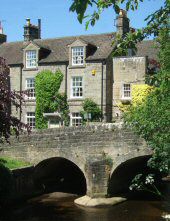
6. Barbrook Bridge carried the original turnpike across Chatsworth land to Robin Hood and Chesterfield. When the Duke of Devonshire extended the Park in 1824, he had the turnpike diverted northwards.
7. The Cavendish Hotel was initially known as the Peacock, the arms of its original owner, the Duke of Rutland. The Duke of Devonshire acquired it in 1860, but only after refurbishment in 1970 was the name changed to the family name of Cavendish.
8. St Anne’s Churchyard contains about 850 gravestones. The earliest burial recorded was that of Thomas Baggeley in 1698. It has a Saxon coffin lid at the porch entrance and a medieval cross near the church entrance.
9. Baslow Hall’s age is misleading. Although it looks like a typical 17th-century Derbyshire Manor house, it was built in 1907 by Rev Stockdale, the local vicar.
10. The area close to the old bridge was once the village’s commercial centre. Various artisans and shopkeepers worked from the buildings on the north side of the road.
Baslow Edge Walk
